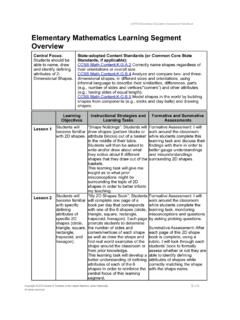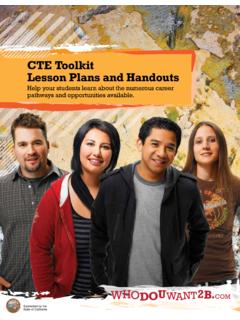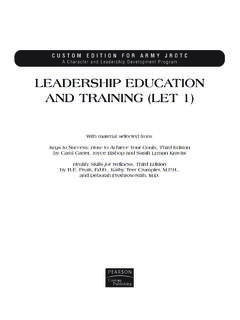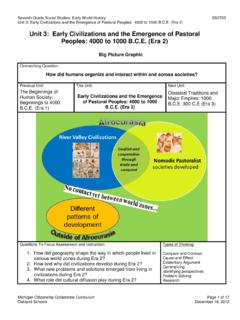Transcription of Three Dimensional Shapes Grade: Kindergarten Math Unit …
1 Three Dimensional Shapes Grade: Kindergarten Math Unit for 10 days with 30 minutes a day Christina Marsicano, Kate Simpson, and Julie Doran 1. Overview and Rationale In this unit we will be teaching students about Three - Dimensional Shapes . At first we will review some of the two- Dimensional Shapes that the students have previously learned and discuss what dimension actually means. This will allow the students to understand the relationship and differences between two Dimensional Shapes to the various attributes of some of the faces or different aspects of Three - Dimensional Shapes . Each day the students will learn what a cylinder, sphere, cone, sphere, rectangular prism, triangular prism, and pyramid are. The students will be able to identify the attributes of each shape which include number of faces, edges, corners, and so forth. Students should be able to apply their knowledge of the Shapes in order to find these Shapes in their everyday life, as well as how to create these Shapes in their own way (whether that is in a drawing, a model, finding an example, etc).
2 This unit is related to the following common core standards: Correctly name Shapes regardless of their orientations or overall size. Identify Shapes as two- Dimensional (lying in a plane, flat ) or Three - Dimensional ( solid ). Analyze and compare two- and Three - Dimensional Shapes , in different sizes and orientations, using informal language to describe their similarities, differences, parts ( , number of sides and vertices/ corners ) and other attributes ( , having sides of equal length). Model Shapes in the world by building Shapes from components ( , sticks and clay balls) and drawing Shapes . There will be a gradual introduction of the new Shapes to the students each day, and the lessons provide students with multiple means of learning, exploring, creating, and experimenting with the different Three - Dimensional Shapes . Unpacking Standards What do these standards mean a child will know and be able to do?
3 2. Students locate and identify Shapes in their environment. For example, a student may look at the tile pattern arrangement on the hall floor and say, Look! I see squares! They are next to the triangle. At first students may use informal names , balls, boxes, cans . Eventually students refine their informal language by learning mathematical concepts and vocabulary and identify, compare, and sort Shapes based on geometric attributes. Students also use positional words (such as those italicized in the standard) to describe objects in the environment, developing their spatial reasoning competencies. Kindergarten students need numerous experiences identifying the location and position of actual two- and- Three - Dimensional objects in their classroom/school prior to describing location and position of two-and- Three -dimension representations on paper. Through numerous experiences exploring and discussing Shapes , students begin to understand that certain attributes define what a shape is called (number of sides, number of angles, etc.)
4 And that other attributes do not (color, size, orientation). As the teacher facilitates discussions about Shapes ( Is it still a triangle if I turn it like this? ), children question what they see and begin to focus on the geometric attributes. Kindergarten students typically do not yet recognize triangles that are turned upside down as triangles, since they don't look like triangles. Students need ample experiences manipulating Shapes and looking at Shapes with various typical and atypical orientations. Through these experiences, students will begin to move beyond what a shape looks like to identifying particular geometric attributes that define a shape. Students identify objects as flat (2 Dimensional ) or solid (3 Dimensional ). As the teacher embeds the vocabulary into students' exploration of various Shapes , students use the terms two- Dimensional and Three - Dimensional as they discuss the properties of various Shapes .
5 Differentiated instruction to provide all students with the tools they need to be successful in learning this topic is very important. Through the use of visual charts, students can see the explanation of the different parts of a Three - Dimensional shape (face, 3. edge, point, etc). Using a scavenger hunt to find Shapes around the classroom and the school, students are able to connect their learning of the Shapes to the environment around them. Another way to engage and adapt the lessons to student needs is to have them choose either to physically model their shape with clay or other substance or choose to draw examples of different Shapes using their prior knowledge as well as what they have recently learned. Making connections between two- Dimensional Shapes and the Three - Dimensional Shapes will allow students to better understand how these Shapes are also readily available and seen in their everyday life.
6 In future grades students will be able to apply the knowledge they learn from this unit to identify new Shapes , graph Shapes , and also to be able to describe different objects they encounter in their everyday lives. 4. Guiding Questions and Vocabulary What is a Three Dimensional shape? What are the different kinds of Three Dimensional Shapes ? Where do I see Three Dimensional Shapes in my everyday life? How can I use Three Dimensional Shapes to make a product? Vocabulary List Three Dimensional , two Dimensional , shape, fat, flat, shape, length, width, height, attribute, side, face, edge, corner, cube, sphere, cylinder, cone, rectangular prism, triangular prism, product 5. Calendar and Lesson Log DAY 1: DAY 2: DAY 3: DAY 4: DAY 5: What is a 3- Exploring Exploring Exploring Exploring Dimensional Cubes Spheres Cylinders Rectangular Shape? Prisms . DAY 6: DAY 7: DAY 8: DAY 9: DAY 10: Exploring Exploring We're Going on Making 3D My 3D Shape Cones Pyramids a Shape Hunt Models Book.
7 Day 1. Initiating Investigation: What is a 3- Dimensional Shape? . As a class, students will define what 3- Dimensional means. Students will engage prior knowledge in order to compare 3- Dimensional Shapes to 2- Dimensional Shapes that they learned about earlier in the year. Students will be introduced to key vocabulary that will be reiterated and built upon throughout the remainder of the unit. The majority of this lesson will be in a whole class discussion format with opportunities for students to turn and talk to a partner about observations they are making about 3D Shapes . This lesson will be described in more detail in one of the following edTPA plans. Assessment: Students will be informally assessed as the teacher observes their partner discussions during the introductory lesson. The way in which this assessment will be enacted is described in the assessment section of this unit plan.
8 Day 2. 6. Exploring Cubes . Students will be introduced to their first 3- Dimensional shape, the cube. Defining attributes will be discussed and listed as students hold, manipulate and observe a cube. In order to facilitate this discussion a laminated version of the cube shape description (attached in appendix section) will be displayed at the front of the room and the teacher will write down attributes as the students investigate the shape. Students will then be asked to complete a cube page (attached in appendix section) that describes the attributes of a cube along with a real world example of a cube. This page will be combined with all the other shape pages and at the end of the unit, students will each have a 3D shape book. If students finish early they can work on the carpet and complete a shape sort, or a cube book (attached in appendix section). Assessment: By completing their cube page and/or extension activities, with limited difficulty, students will demonstrate their mastery of understanding cubes as well as the defining attributes of cubes.
9 Day 3. Exploring Spheres . Students will be introduced to another 3- Dimensional shape, the sphere. Defining attributes will be discussed and listed as students hold, manipulate and observe a sphere. In order to facilitate this discussion a laminated version of the sphere shape description (attached in appendix section) will be displayed at the front of the room and the teacher will write down attributes as the students investigate the shape. Students will then be asked to complete a sphere page (attached in appendix section) that describes the attributes of a sphere along with a real world example of a sphere. This page will be combined with all the other shape pages and at the end of the unit, students will each have a 3D shape book. If students finish early they can work on the carpet and complete a shape sort, or a sphere book (attached in appendix section). Assessment: By completing their sphere page and/or extension activities, with limited difficulty, students will demonstrate their mastery of understanding spheres as well as the defining attributes of spheres.
10 7. Day 4. Exploring Cylinders . Students will be introduced to another 3- Dimensional , a cylinder. Defining attributes will be discussed and listed as students hold, manipulate and observe a cylinder. In order to facilitate this discussion a laminated version of the cylinder shape description (attached in appendix section) will be displayed at the front of the room and the teacher will write down attributes as the students investigate the shape. Students will then be asked to complete a cylinder page (attached in appendix section) that describes the attributes of a cylinder along with a real world example of a cylinder. This page will be combined with all the other shape pages and at the end of the unit, students will each have a 3D cylinder book. If students finish early they can work on the carpet and complete a shape sort, or a cylinder book (attached in appendix section). Assessment: By completing their cylinder page and/or extension activities, with limited difficulty, students will demonstrate their mastery of understanding cylinders as well as the defining attributes of cylinders.








